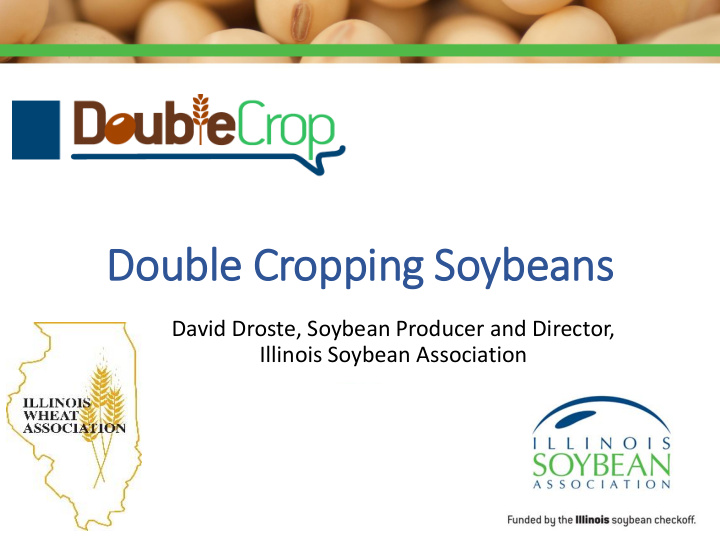



Double Cropping Soybeans David Droste, Soybean Producer and Director, Illinois Soybean Association
Double Cropping - Wheat • Washington County, Illinois • My operation has been double cropping since the early 1970's • Double cropping is generally more profitable than a single crop in a year • Select wheat varieties for early harvest that fit your area. • Pay attention to fertility since you are growing two crops. • Harvest wheat as early as possible preferably around 20% moisture. • Be prepared to act and harvest quickly 2
Double Cropping - Soybeans • Think about the soybean variety, one that performs when planted later as a double crop. • Use treated seed. • Plant beans ASAP, preferably within 24 hours after wheat harvest. • Planting within 24 hours can reduce hair-pinning of straw in seed furrow. • Population and row spacing are important. • Weed control is important, have a plan for resistant weeds. • Always scout for insect and disease pressure. • Treat double crop soybeans like your full season beans. 3
Soybean Omission Plots – Average of all Trials 2012-13 Standard High Tech D D Factor Yield Yield bu acre -1 58.6 66.8 None or All 62.2 +4.0* 63.6 -3.2* Fertility 60.4 +2.0* 65.0 -1.8* Fungicide 60.2 +2.2* 64.8 -2.0* Insecticide 61.6 +3.2* 63.8 -3.0* Fung. + Insect. 60.0 +1.4* 64.2 -2.6* Seed treatment 59.4 +0.8 64.3 -2.5* Row Arrangement *Significantly different from standard at P ≤ 0.05. Average of 6 trials in 2012 and 8 trials in 2013 with two varieties in each trial
Crop Insurance Pitfall • Qualifying to insure double crop soybeans on an equitable basis • RMA is being asked to: • Providing greater flexibility in determining double crop eligibility • Providing full coverage on both crops in a double cropping situation if an independent agricultural expert certifies that a particular crop combination is a recognized good farming practice in a given county; • The basis for double cropping qualification should be the percentage of acreage the producer historically double crops 5
Crop Insurance Pitfall Double cropping insurance rules are guided by section 508A(d) the Federal Crop Insurance Act (Act) specifying that a producer may receive full indemnity payments on two or more crops planted for harvest in the same crop year if each of the following conditions are met: 1. There is an established practice of planting two or more crops for harvest in the same crop year in the area, as determined by the Corporation. 2. An additional coverage policy or plan of insurance is offered with respect to the agricultural commodities planted on the same acreage for harvest in the same crop year in the area. 3. The producer has a history of planting two or more crops for harvest in the same crop year or the applicable acreage has historically had two or more crops planted for harvest in the same crop year. 4. The second or more crops are customarily planted after the first crop for harvest on the same acreage in the same year in the area. 6
Crop Insurance Pitfall RMA seeks comment from stakeholders in the Federal crop insurance program regarding the following issues and proposed alternatives related to the definition of “practical to replant” and double cropping eligibility and related provisions. • Current double cropping requirements do not recognize changes in growing farm operations or for added land • There is confusion regarding the “two of the last four crop years” language and double cropping requirements. • Some producers have found challenges keeping separate records of acreage that was and was not double cropped because they harvest both first/second crop production at the same time. RMA has proposed some solutions to these issues during its open comment period. 7
Recommend
More recommend